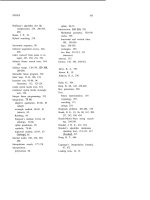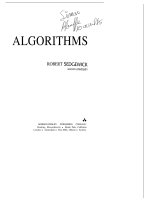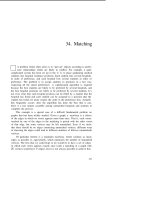Tài liệu Thuật toán Algorithms (Phần 46) ppt
Bạn đang xem bản rút gọn của tài liệu. Xem và tải ngay bản đầy đủ của tài liệu tại đây (71.08 KB, 10 trang )
34. Matching
A problem which often arises is to “pair up” objects according to prefer-
ence relationships which are likely to conflict. For example, a quite
complicated system has been set up in the U. S. to place graduating medical
students into hospital residence positions. Each student lists several hospitals
in order of preference, and each hospital lists several students in order of
preference. The problem is to assign students to positions in a fair way,
respecting all the stated preferences. A sophisticated algorithm is required
because the best students are likely to be preferred by several hospitals, and
the best hospital positions are likely to be preferred by several students. It’s
not even clear that each hospital position can be filled by a student that the
hospital has listed and each student can be assigned to a position that the
student has listed, let alone respect the order in the preference lists. Actually
this frequently occurs: after the algorithm has done the best that it can,
there is a last minute scramble among unmatched hospitals and students to
complete the process.
This example is a special case of a difficult fundamental problem on
graphs that has been widely studied. Given a graph, a matching is a subset
of the edges in which no vertex appears more than once. That is, each vertex
touched by one of the edges in the matching is paired with the other vertex
of that edge, but some vertices may be left unmatched. Even if we insist
that there should be no edges connecting unmatched vertices, different ways
of choosing the edges could lead to different numbers of leftover (unmatched)
vertices.
Of particular interest is a mazimum matching, which contains as many
edges as possible or, equivalently, which minimizes the number of unmatched
vertices. The best that we could hope to do would be to have a set of edges
in which each vertex appears exactly once (such a matching in a graph with
vertices would have V edges), but it is not always possible to achieve this.
443
444
CHAPTER 34
For example, consider our sample undirected graph:
The edges AF DE CG LM make a maximum matching for this graph,
which is the best that can be done, but there’s no three-edge matching for
the consisting of just the first six vertices and the edges connecting
them.
For the medical student matching problem described above, the students
and hospitals would correspond to nodes in the graph; their preferences to
edges. If they assign values to their preferences (perhaps using the
honored “l-10” scale), then we have the weighted matching problem: given
a weighted graph, find a set of edges in which no vertex appears more than
once such that the sum of the weights on the edges in the set chosen is
maximized. Below we’ll see another alternative, where we respect the order in
the preferences, but do not require (arbitrary) values to be assigned to them.
The matching problem has attracted attention because of its intuitive
nature and its wide applicability. Its solution in the general case involves
intricate and beautiful combinatorial mathematics beyond the scope of this
book. Our intent here is to provide the reader with an appreciation for the
problem by considering some interesting special cases while at the same time
developing some useful algorithms.
Bipartite Graphs
The example mentioned above, matching medical students to residencies, is
certainly representative of many other matching applications. For example,
we might be matching men and women for a dating service, job applicants to
available positions, courses to available hours, or congressmen to committee
assignments. The graphs resulting from modeling such cases are called bipar-
tite graphs, which are defined to be graphs in which all edges go between two
sets of nodes (that is, the nodes divide into two sets and no edges connect
two nodes in the same set). Obviously, we wouldn’t want to “match” one job
applicant to another or one committee assignment to another.
The reader might be amused to search for a maximum matching in the
typical Lipartite graph drawn below:
In an adjacency matrix representation for bipartite graphs, one can achieve
obvious savings by including only rows for one set and only columns for the
other set. In an adjacency list representation, no particular saving suggests
itself, except naming the vertices intelligently so that it is easy to tell which
set a vertex belongs to.
In our examples, we use letters for nodes in one set, numbers for nodes
in other. The maximum matching problem for bipartite graphs can be
simply expressed in this representation: “Find the largest subset of a set of
letter-number pairs with the property that no two pairs have the same letter
or number.”
Finding the maximum matching for our example bipartite graph
corresponds to solving this puzzle on the pairs E5 A2 Al Cl B4 C3 D3 B2 A4
D5 E3
It is an interesting exercise to attempt to find a direct solution to the
matching problem for bipartite graphs. The problem seems easy at first
glance, but subtleties quickly become apparent. Certainly there are far too
many pairings to try all possibilities: a solution to the problem must be clever
enough to try only a few of the possible ways to match the vertices.
The solution that we’ll examine is an indirect one: to solve a particular
instance of the matching problem, we’ll construct an instance of the network
flow problem, use the algorithm from the previous chapter, then use the
solution to the network flow problem to solve the matching problem. That is,
we reduce the matching problem to the network flow problem. Reduction is a
rnethod of algorithm design somewhat akin to the use of a library subroutine
by a systems programmer. It is of fundamental importance in the theory
of advanced combinatorial algorithms (see Chapter 40). For the moment,
reduction will provide us with an efficient solution to the bipartite matching
problem.
The construction is straightforward: given an instance of bipartite
CHAPTER 34
ing, construct an instance of network flow by creating a source vertex with
edges pointing to all the members of one set in the bipartite graph, then make
all the edges in the bipartite graph point from that set to the other, then add
a sink vertex pointed to by all the members of the other set. All of the edges
in the resulting graph are given a capacity of 1. For example, the bipartite
graph given above corresponds to the network below: the darkened edges show
the first four paths found when the network algorithm of the previous
chapter is run on this graph.
Note that the bipartite property of the graph, the direction of the flow, and
the fact that all capacities are 1 force each path through the network to
correspond to an edge in a matching: in the example, the paths found so far
correspond to the partial matching Al B2 C3 D5. Each time the network flow
algorithm calls pfs it either finds a path which increases the flow by one or
terminates.
Now all forward paths through the network are full, and the algorithm
must use backward edges. The path found in this example is the path
This path clearly increases the flow in the network, as described in
the previous chapter. In the present context, we can think of the path as a set
of instructions to create a new partial matching (with one more edge) from the
current one. This construction follows in a natural way from tracing through
the path in order: means to add A4 to the matching, which requires
MATCHING
that “Al” be deleted; means to add Cl to the matching, which requires
that “C3” be deleted; means to add E3 to the matching. Thus, after
this path is processed, we have the matching A4 B2 Cl D5 E3; equivalently,
the flow in the network is given by full pipes in the edges connecting those
nodes, and all pipes leaving 0 and entering Z full.
The proof that the matching is exactly those edges which are filled to
capacity by the algorithm is straightforward. First, the network flow
always gives a legal matching: since each vertex has an edge of capacity 1
either coming in (from the sink) or going out (to the source), at most one unit
of flow can go through each vertex, which implies that each vertex will be
included at most once in the matching. Second, no matching can have more
edges, since any such matching would lead directly to a better than that
produced by the algorithm.
Thus, to compute the maximum matching for a bipartite graph we simply
format the graph so as to be suitable for input to the network flow algorithm
of the previous chapter. Of course, the graphs presented to the network flow
algorithm in this case are much simpler than the general graphs the algorithm
is designed to handle, and it turns out that the algorithm is somewhat more
efficient for this case. The construction ensures that each call to pfs adds
one edge to the matching, so we know that there are at most calls to
pfs during the execution of the algorithm. Thus, for example, the total time
to find the maximum matching for a dense bipartite graph with V vertices
(using the adjacency matrix representation) is proportional to
Stable
Marriage Problem
The example given at the beginning of this chapter, involving medical students
and hospitals, is obviously taken quite seriously by the participants. But
the method that we’ll examine for doing the matching is perhaps better
understood in terms of a somewhat whimsical model of the situation. We
assume that we have N men and N women who have expressed mutual
preferences (each man must say exactly how he feels about each of the N
women and vice versa). The problem is to find a set of N marriages that
respects everyone’s preferences.
How should the preferences be expressed? One method would be to use
the scale, each side assigning an absolute score to certain members of
the other side. This makes the marriage problem the same as the weighted
matching problem, a relatively difficult problem to solve. Furthermore, use of
absolute scales in itself can lead to inaccuracies, since peoples’ scales will be
inconsistent (one woman’s 10 might be another woman’s 7). A more natural
way to express the preferences is to have each person list in order of preference
all the people of the opposite sex.
The following two tables might show









